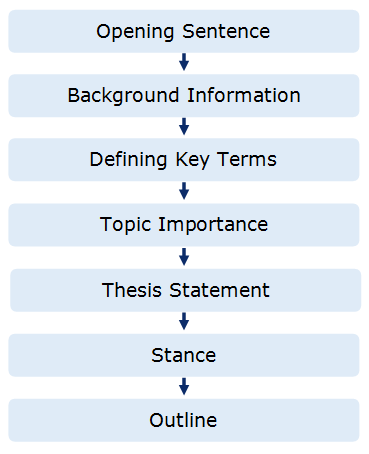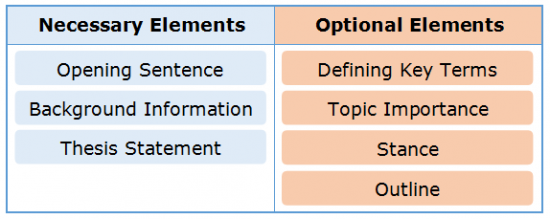What are some possible introductory paragraph structures?

This is the third of four chapters about Introductory Paragraphs. To complete this reader, read each chapter carefully and then unlock and complete our materials to check your understanding.
– Introduce the concept of structure in an introduction
– Describe the five key structural considerations
– Provide examples and diagrams for each structure
Before you begin reading...
-
video and audio texts
-
knowledge checks and quizzes
-
skills practices, tasks and assignments
Chapter 3
Although there is always flexibility in essay writing to structure your introduction in a number of ways, there are five key aspects of structure that are worth mentioning in some detail. A student that’s able to consider the purpose, language, elements and structure of their introduction is much more likely to produce consistent and high-level academic essays.
1. Logical Ordering
One of the most important general aspects of essay writing is that the writer maintains a coherent and logical order, and this is no different for the introduction. The elements that we provided in the previous lesson were listed in the order that’s generally considered to be the most logical:

A writer cannot, for example, logically define key terms before they’ve at least introduced the topic through some basic background information that writer had even indicated what the essay planned to argue or explore through a thesis statement. By following the general order of elements as listed above, you should guarantee that your introduction is more cohesive.
2. Necessary, or Optional?
Another structural consideration when writing an introduction is whether or not you need to include every introductory element:

While it might be almost mandatory to include thesis statements and background information in your introduction, whether or not you provide your reader with a definition of key terms or highlight the topic importance is really decided by the topic being investigated. Without difficult vocabulary items for example, it would be unnecessary to add such definitions, and only some essay types will even require the inclusion of stance. Some elements, however, such as an outline may ultimately be optional, but still come highly recommend by tutors for clarity’s sake.
3. General to Specific
One of the most important aspects about structuring an introduction relates to the macro (overall) structure of the paragraph content, in which a recommended direction is to move from general (broad) to specific (focussed):

What the previous upside-down triangle shows is that the ordering of the elements we demonstrated earlier is logical precisely because such elements move from a general structure, in which the essay topic is introduced and contextualised, to a more specific structure, in which the specific essay purpose, writer stance and argument structure is explained to the reader.
4. Counter Argument > Argument
One additional structure that’s particularly useful with persuasive or evaluative essays (in which the writer must present an argument or stance) is to begin the introduction by first introducing the counter argument – which is the argument that the writer doesn’t agree with.
As can be seen in the following diagram, the first four elements are orange to indicate that these elements may be introduced from the perspective of the counter argument, perhaps by introducing and outlining the benefits of using technology in the classroom. The blue elements, however, may be written from the perspective of the writer’s argument, perhaps in turn highlighting to the reader that although there may be some benefits to such technology, overall this technology is no more beneficial to language learning than more traditional methods:

5. Length
One final consideration of structure is regarding the essay length. Such length of course depends on the essay type being written, but in general for three– and five-paragraph essays, as well as for extended essays, the introduction is normally one paragraph of between 150 to 250 words in length. In a one-paragraph essay, the introduction may simply be a single sentence, and in a dissertation or thesis, the introduction could be many paragraphs long.
To reference this reader:
Academic Marker (2022) About Introductory Paragraphs. Available at: https://academicmarker.com/essay-writing/introductory-paragraphs/about-introductory-paragraphs/ (Accessed: Date Month Year).
Downloadables
Once you’ve completed all four chapters about introductory paragraphs, you might also wish to download our beginner, intermediate and advanced worksheets to test your progress or print for your students. These professional PDF worksheets can be easily accessed for only a few Academic Marks.
Collect Academic Marks
-
15 Marks for joining
-
3 Marks for daily e-learning
-
10-20 for feedback and testimonials
-
10-50 for referring others